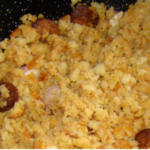It is very common to hear people wonder if a food contains gluten or not, since celiac disease is one of the most recurrent food intolerances in the world today (it is estimated that 1% of the world population suffers from this disorder).

There are many gluten-free products on the market, which supplant the traditional foods that contain this protein, but what about products that we assume are naturally gluten-free? If you are wondering if rice has gluten or not, we invite you to find out in this article.
Does rice have gluten? – The answer
Rice is known as a food belonging to the group of gluten-free cereals, which is why it is highly recommended for celiac patients. However, rice contains origin (approximately 5%), a glia din-like protein (protamine) found in wheat (contains 69%). Protamine is a type of plant protein responsible for causing celiac disease. Currently, the possibility that origin and other similar polyamines can generate some type of immune reaction after consumption, as occurs with wheat glia din, due to the similarity of their structures, is being studied. However, until now there is no confirmation of this hypothesis.
By considering rice as a gluten-free cereal itself, we also cannot rule out the possibility of other types of contamination, such as cross-contamination and others. In the case of cross-contamination, this can occur in: cultivation, during transportation, storage, and manufacturing (grinding, subsequent transportation and storage), at home and restaurants (improper handling of food in the kitchen, poor storage and poor handling food at the table).
In the kitchen in general and especially the “Without TACC” (without wheat, oats, barley and rye), rice represents an excellent alternative, as it is very versatile. You can buy this cereal in the form of flour, starch, broken grain, semolina, puffed rice (but not puffed with malt extract or syrup, as both contain gluten), roasted rice powder or Kao Kea, rice bran, among others. Thanks to its various presentations and uses, you can enjoy it in: bread, pasta, biscuits, muesli, cookies, sauces, as a food thickener and other bakery and confectionery products that have nothing to envy to those prepared with wheat. However, due to certain specific characteristics of gluten that rice does not have, when preparing breads and cakes it is necessary to mix several types of flour and starch, such as corn, cassava,
Composition and properties of rice
Rice is composed of 70-80% starch; therefore this is its main component, also present in the rest of the cereals, root vegetables and tubers. On the other hand, this cereal is made up of proteins in a fairly moderate percentage, around 7% (approximately 6.67 grams per 100 grams of product). In addition, it has a representative amount of fiber called cellulose, specifically indicated for intestinal health, especially when it retains its shell. In this way, brown rice has 1.4 grams per 100 grams of product, compared to 0.5 grams of white rice.
As for the rest of the nutrients, vitamins and minerals abound, such as thiamin or vitamin B1, riboflavin or vitamin B2, niacin or vitamin B, phosphorus, magnesium and potassium. However, during the industrial refining and polishing process, rice loses many nutritional substances, around 50% of minerals and 85% of B vitamins, thus becoming a more energetic than nutritious food. However, many manufacturers enrich the rice to compensate for the losses of nutritional substances during the industrial process.
Benefits of rice
Rice in all its presentations provides a large number of benefits to the body, among which we can highlight:
- It is a gluten-free cereal, which is why it is ideal for celiac people.
- It is an important source of energy for the body due to its high content of carbohydrates.
- It provides valuable nutrients for the body, especially brown rice, since it maintains much of its nutritional value.
- It contains very little saturated fat and cholesterol, and also has powerful antioxidant properties. Due to both characteristics, it is a highly recommended food for heart health.
- It has a high content of neurotransmitters in its integral version, which reduces the possibility of the appearance of Alzheimer’s.
- It provides a very low index of fats and carbohydrates, which is why it favors weight loss. For more information on this, see this article: “Is rice fattening? “.
- Its sodium content is very low; therefore, it contributes to the control of blood pressure.
- Its high doses of fiber make it the ideal food to prevent chronic diseases of the digestive system, both stomach and intestinal.
- Helps control constipation. This cereal has abundant fiber, especially in its integral version, which contributes to the growth of favorable bacteria to improve digestion and regulate intestinal movement.
- Rice husk has diuretic qualities and is also a very effective medicine to counteract dysentery.
- It contains a good amount of B complex vitamins. For this reason, it is an effective ally for the protection of the nervous and muscular systems.
Does rice flour have gluten?
Rice flour is gluten free. In the same way that the whole grain does not have this protein, its flour version does not either. For this reason, rice flour is a type of flour widely used by people intolerant to gluten to make batters or pastry products. Some gluten-free recipes that you can make with rice flour are:
- Biscuits with rice flour
- Pancakes with rice flour
- Bread with rice flour
And does brown rice have gluten?
Both white and brown rice are they gluten-free, but you should always remember to check the label, as there is potential for cross-contamination. However, for people with celiac disease, diabetics, vegans, vegetarians and many others, it is an excellent alternative to consume brown rice, since it contains many more nutrients than white rice, has a lower glycemic index and provides much more fiber.
Tip: Brown rice has the highest level of B vitamins of all grains.
Foods with gluten
Although gluten is mainly found in wheat and some other cereals, in the food industry it is used both in baking and as additives in many products (for example, thickeners). In other words, although not all processed foods contain gluten, a very significant amount does, which is why it is essential for anyone with celiac disease to consult the product label. What is indicated is that they say “No TACC” (without toxic proteins for celiac) or “Gluten free”, since if they only say “Wheat free” it does not mean that they are gluten free, since they may contain barley, rye or their derivatives. Also, do not trust products that do not naturally contain gluten, since they may be affected by cross-contamination.
On the other hand, it is also very important to consider that even if you always buy the same product, in the food industry the ingredients tend to change frequently (in many cases), so you should always check the label. Finally, when in doubt, whether or not a product contains gluten, do not buy it. Taking all these details into consideration, it is essential to know some products that contain gluten as a reference:
- White flour
- Graham flour
- Durum wheat
- Kaput wheat
- Tritium
- Triticale (a cross between wheat and rye)
- Spelled (spelt)
- Wheat germ
- Wheat Bran
- Pasta
- Bread and all kinds of pastries
- Flour tortillas
- Cereals
- Bread crumbs
- Prepared dough’s
- Oatmeal
- Couscous
- Beers
- Malt
- Syrups
- Chocolate with sugar
- Concentrated soup cubes
- Sausages
- Salad dressings
- Rice (some due to cross contamination)
- Corn flour (for cross contamination)
- Wafers (including communion wafers)
- Stevia
- Coffee (in capsules or instant)
- Jellies
- Dairy and derived products
- Dehydrated fruits (figs, ears, etc.)
- Precooked and dehydrated vegetables
- Canned or packaged foods
- Candies
Does oatmeal have gluten?
As we have mentioned, oats contain evening, a type of protamine, which is why it is considered to have a small percentage of gluten. However, the effects of oats in people intolerant to gluten are still being analyzed today. For this reason, it is considered a gluten-free cereal. The main problem with oats is that they tend to present cross-contamination, that is, they tend to be contaminated with gluten during the preparation processes. Therefore, it is essential to check the packaging.
Do potatoes have gluten?
No, the potato does not have gluten, so it is an excellent food for people with celiac disease.



